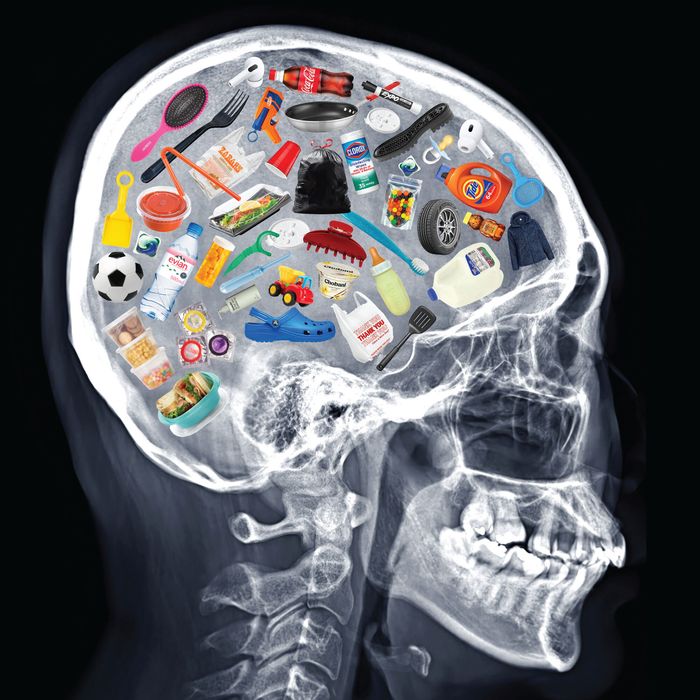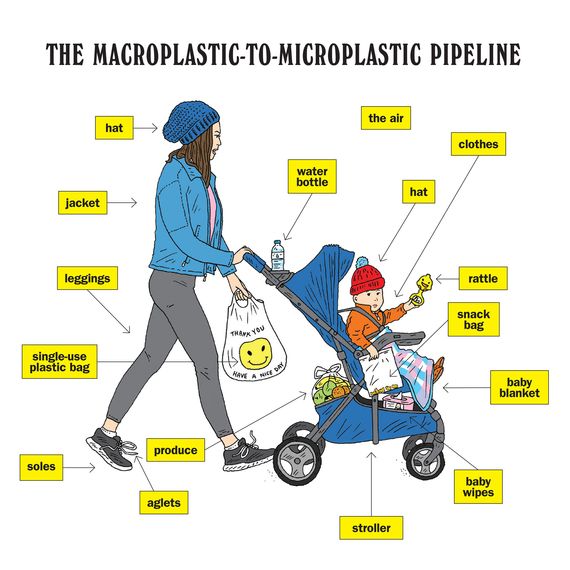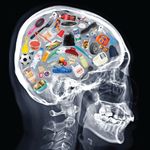
In 2019, a toxicologist named Matthew Campen drove into the wilderness of the San Juan Mountains in northern New Mexico with his 12-year-old son. They were working on a school science project about plastic waste, comparing samples from different points along the Rio Grande. In the shadows of the rugged, snow-capped peaks, they knelt at the edge of the river and collected water in glass jars.
Campen had not been surprised when the water samples they collected from around Albuquerque, where they lived, were full of microplastics — pieces of plastic under five millimeters, the size of a grain of rice. But when they analyzed the samples from the seemingly pristine forest in the San Juans, he was amazed to find microplastics there, too. “Even near the head-waters of the Rio Grande, it was super-easy to find these things,” he told me.
Campen, who runs a lab at the University of New Mexico College of Pharmacy, is an inhalation toxicologist who studies the impact of smoking, wildfires, and other respiratory pollutants. “I basically was like, We eat and breathe rocks all the time, and we’re exposed to little particles of diesel,” he said, “so who even cares about plastics? ” The results of his son’s experiment shifted his focus.
Earlier this month, six years after that pivot, Campen published an alarming paper that made headlines around the world. The adult human brain, his research found, today contains about a disposable spoon’s worth of plastic — roughly 50 percent more than eight years ago. The rate of accumulation mirrors the rate that plastic is increasing in prevalence in our environment. “It’s frighteningly correlated,” he said when he announced his results. To illustrate his findings, Campen, who is sandy-haired with a youthful face and a wry sense of humor, held a disposable spoon next to his head. “My prop,” he called it. “I certainly don’t feel comfortable with this much plastic in my brain,” he said, “and I don’t need to wait around 30 more years to find out what happens if the concentrations quadruple.”
To conduct the study, Campen’s lab obtained brain, liver, and kidney specimens from people who died in either 2016 or 2024. To isolate the plastic embedded in the samples, they applied a solution that chemically digested the tissue. “Have you seen Breaking Bad?” Campen asked me. “They used acid. We’re using the opposite of that. Just a really powerful base of potassium hydroxide.” Whatever remained was spun in a centrifuge to create a pellet, which could be chemically analyzed. Other methods to identify microplastics in environmental samples allow researchers to see particles larger than five micrometers. Campen’s method can detect and measure nanoplastics, which are smaller than one micrometer, or one-1,000th of a millimeter. The particles they saw in the brain samples were 200 nanometers — about the same size as two COVID-19 viruses side by side.
He was astonished that the brain samples had seven to 30 times more plastic than those from the livers or kidneys. One contributing reason may be that brain tissue is extremely fatty and plastics like to glom on to fat. “Our team had to repeat the findings a lot before I was willing to believe them,” Campen said. Nanoplastics, it seemed, can travel almost anywhere in the body, including across the blood-brain barrier, once they are ingested or inhaled and then absorbed into the bloodstream.
After getting the results from their experiments, Campen and his team went looking for even older samples. (“It’s sometimes a challenge to find brains,” he said.) Eventually, a colleague from Duke University sent him specimens from as far back as 1997. These older brains had even less plastic, a finding that supported the bioaccumulation trend they had seen. Of the 12 types of polymers they detected in the more recent brain samples, polyethylene (used to make single-use bottles, bags, and even, sometimes, utensils) was the most prevalent. It’s also the most common plastic in the world.
Campen acknowledged that we still don’t know what his findings — or any discoveries of bodily plastics — mean, exactly, for human health. But the evidence we have, based mainly on studies of mice and cell cultures, is suggestive. Though correlation isn’t causation, it’s worth keeping track of all the correlations.
Researchers are studying at least two possible mechanisms for micro- and nanoplastics to harm the human body. By physically occupying space in organs and cells, they could disrupt cell function, block molecular messengers, and trigger inflammation. If the body is constantly producing this inflammatory response, there may be an increased risk for a host of diseases. The presence of microplastics has been linked to cardiovascular disease and reduced sperm count and suspected of links to lung cancer, colon cancer, and dementia.
Other studies have looked at the way the chemical compounds in these particles might harm the body. Some of the most common additives in plastics, like bisphenols and phthalates — which make products more flexible, durable, or flame resistant — have been extensively studied for decades. These additives are known to be endocrine disrupters, meaning they can wreak havoc on our hormones; this can be particularly dangerous for the developing bodies of infants and children. Once lodged in our tissues, microplastics may leach these chemical compounds continually into our bodies. They are “what we call sustained-release vehicles,” Don Ingber, a professor at Harvard’s medical and engineering schools, told the Harvard Gazette. “They’re just sitting there, and every day they’re releasing a little bit for the rest of the lifetime of those cells in your gut or other organs.”
Campen is now working on experiments that, he hopes, will decisively connect microplastics in the body to human-health effects. “I mean, if you believe at face value the amount of plastics we’re showing in the brain,” he told me, it makes you wonder, “How are we even alive? ”
I spoke to dozens of researchers who agreed that microplastics represent a public-health crisis. “I can say, with a high degree of confidence, that microplastic particles are in the bodies of virtually every American today,” Philip Landrigan, a pediatrician and epidemiologist at Boston College and the author of a recent major report on plastics and health, told me. “They are loaded with chemicals, which leach out of the microplastic particles, and cause disease in the human body.” He is frustrated that we haven’t done more to address the problem. “One of the things you learn in medicine,” he said, “is when you have a sick patient in the emergency room, you have to make decisions quickly, even before all the data comes in.”
The word MICROPLASTIC was coined only two decades ago in the 2004 paper “Lost at Sea: Where Is All the Plastic?” by British marine biologist Richard Thompson. He and others had found that small colorful fragments of common plastics were extremely abundant along the coast of the U.K. By comparing modern plankton samples with ones from as far back as the 1960s, Thompson determined that the number of microplastics had increased significantly since then.
The field of microplastics remained relatively small until the Great Pacific Garbage Patch became nonscientifically famous. A photograph of a seabird with a plastic-stuffed belly went viral, as did a bloody video of a sea turtle with a straw deeply embedded in one of its nostrils. Researchers started to realize, then confirm, that all this macroplastic was slowly breaking down into microplastics, which formed the bulk of the plastic in the ocean. (Less than 10 percent of all the plastic ever produced has been recycled.) These billions — or trillions, once nanoplastics were considered — of chemical-laced, weathered polymer specks would persist for eons, were mostly impossible to clean up, and have been found to be toxic, sometimes even deadly, to many aquatic animal species. One study published this past fall included the grim news that microplastics were found in dolphin breath.
To chart the increasing volume of microplastics on earth, some scientists turned to ice and sediment cores, which function like tree rings. Each layer is a time capsule, a frozen snapshot of what happened on the planet in one year. When Jenni Brandon was a graduate student at the Scripps Institution of Oceanography, she analyzed some extremely well preserved sediment cores drilled from the Santa Barbara Basin off the coast of California. In her samples, she found the quantity of microplastics in each layer had increased exponentially since the Second World War, doubling every 15 years. “We did not expect to get such a nice exponential curve,” she said.
Microplastics aren’t confined to our oceans; they fill our atmosphere. In his book A Poison Like No Other, the science journalist Matt Simon wrote that each year the equivalent of 5 billion plastic bottles rains down on the U.S. in the form of microplastics. Inside our houses and workplaces, it’s even worse. One study from California found more than six times the number of microfibers indoors compared with outdoors. Carpets are mostly made with synthetic plastics, as are couches, toys, and blankets. People track microplastics into their homes on their shoes — the soles can pick up, especially in cities, chemical-heavy flecks of tire rubble, brake pads, acrylic paint, and construction foam. In 2021, a researcher estimated we inhale roughly 7,000 microplastics a day. Just by moving around in synthetic clothing — items made of polyester, rayon, nylon, or fleece — I may be individually producing as many as 900 million microfibers each year.
The ubiquity of microplastics creates difficulties for those trying to study them. Austin Gray, the co-author of the dolphin paper, told me he spends a lot of his time trying to avoid cross-contamination. When I visited his lab, he opened a tan metal box and removed a glass slide: the preserved remains of a dolphin sigh. In the cabinets above us, Gray indicated the rows of glass petri dishes and beakers covered in aluminum foil. “Because we deal with microplastics, we clean or heat our glassware,” he said, “then we cover it with foil to make sure there’s no introduction from the atmosphere.” The process is time-consuming yet necessary. “It’s pretty tedious, but it helps us control for background. You can’t get rid of everything, but it’s good to do your best and then account for it.” Gray and his students take blank samples from their environment as controls, similar to radio journalists collecting ambient noise. They wear traffic-cone-orange lab coats while they work; fibers from white coats could be mistaken for microplastics in their samples, while orange is relatively rare.
Listing where microplastics are found in our food and beverages starts to become absurd since the list includes most everything. The contamination starts on our croplands, where each year farmers in North America spread up to 660 million pounds of microplastics via sludge, the human waste and other organic matter sourced from wastewater-treatment plants. (In Europe, it approaches a billion pounds.) Sheets of plastic are also used on fields as mulch — more than 13 billion pounds worldwide — and then are left in the soil to disintegrate.
Every time you eat or drink, you are likely ingesting microplastics. Brandon told me she avoids disposable water bottles and foods wrapped in plastic. More surprisingly, she avoids fancy sea salt because it has approximately the same concentration of microplastics as the ocean from which it derives. No shellfish, either, since bivalves like oysters and mussels are filter feeders. Brandon still uses honey, but when honeybees were discovered to carry microplastics on their sticky legs from plant to plant, she was devastated.
Even the most diligent efforts may not be enough. This past year, nanoplastics were found in human testes and ovaries, both of which, like the brain, have a blood-tissue shield. Researchers have found plastics in human hair, saliva, lungs, livers, spleens, and colons. Plastics have been found in placentas, in breast milk, and in meconium — a newborn’s first stool.
“I don’t think you could test anyone and be like, ‘There’s no microplastics in you,’” Imari Walker-Franklin, a research scientist and the co-author of the book Plastics, told me. At this point, simply announcing your lab’s discovery of microplastics in human tissues is obvious or, as Campen put it to me, “a little bit trivial.” Just as we are made of stardust, we are, increasingly, made of plastic.
Some of the earliest evidence we have that microplastics can make us sick comes from the 1970s, when a group of textile workers developed lung damage after extensive exposure to synthetic fibers. Later, at a plant in Rhode Island, several employees who handled nylon flock, which is used to change the texture of some fabrics, developed an interstitial lung disease. It came to be known as flock-worker’s lung.
Occupational exposure is not the same as exposure in the general population, but it can serve as a warning. Even a small amount of micro- or nanoplastic embedded in the body’s tissues could trigger an inflammatory response. “People might think, Oh, it’s a low concentration,” one researcher told me, “but if your body’s constantly producing a response to it, that eventually could lead to an increased risk for certain diseases.”
In 2024, scientists in Italy published a study in The New England Journal of Medicine that found a strong association between micro- and nanoplastics in the human body and cardiovascular disease. The researchers enlisted 257 patients who were having surgery to remove plaque from the blood vessels in their necks. When they examined the plaques to see if they contained microplastics, 58 percent did. The researchers followed up with the patients about three years later and reached an astounding conclusion. The patients whose excised plaques contained microplastics were more than four times likelier to experience heart attack, stroke, or death compared with those who had no microplastics detected. They also had higher levels of inflammation in their blood, which is associated with adverse cardiovascular events. “It’s possible those micro- or nano-plastics may be enhancing, or amplifying, the inflammatory process,” A. Enrique Caballero, a professor at Harvard Medical School and co-author of the NEJM paper, told me.
Other small studies have found correlations between microplastics and health problems elsewhere in the body. The male reproductive system, in particular, seems to be under plastic assault. Men with severe erectile dysfunction were found to have up to seven types of plastic in their penises. (That study, published in 2024 by researchers in Miami, was the first to detect microplastics in human penile tissue, which was extracted from six individuals who were undergoing surgery to get an inflatable prosthesis.) Microplastics have also been found in human semen samples. One experiment conducted in China, from October, found that all the semen and urine samples from 113 men contained microplastics. The samples that contained Teflon (the chemical PTFE), which coats cooking utensils, cutting boards, and nonstick pans, had reduced sperm quality, lower total sperm numbers, and reduced motility.
Last year, Campen conducted a study of 158 human placenta samples and found that those containing higher amounts of plastics belonged to mothers who gave birth preterm. “It’s crazy,” Campen told me, “because those infants are, by definition, like three or four weeks younger than full term. So even though they’ve been in existence for a shorter period of time, they seem to have accumulated more plastics.” Again, it was only a small correlation, “but it absolutely puts plastic uptake in the headlights as a contributor to adverse gestational outcomes,” he said.
Meanwhile, researchers at the University of California, San Francisco, have published a “rapid systematic review” on the human-health effects of microplastics exposure, using strict criteria for the studies they included. They found that, so far, microplastics are suspected of links to colon cancer and certain lung cancers — diseases that have become significantly more prevalent in recent decades. Since 1995, colorectal-cancer diagnoses have doubled for adults under 55, and lung-cancer rates appear to be rising among nonsmokers. “It’s hard to really pinpoint many of these disease end points specifically to plastic, right?” Walker-Franklin said. “It’s hard to have all the controls you need to make a causative relationship.” But the correlations keep coming.
Jaime Ross, a neuroscientist at the University of Rhode Island, has been testing how microplastics affect mice. In one study, she added microplastics to their drinking water to see if it would affect their cognitive function. She didn’t expect much, but after only three weeks, the microplastics had already crossed into the mice’s brains. Moreover, the mice were acting strangely, showing signs of cognitive decline similar to dementia. “We were totally shocked,” Ross told me. She had her graduate students repeat the experiment and got the same results.
One important detail in the design of Ross’s study was that the microplastics used were “clean,” i.e., they contained none of the known toxic chemicals commonly found in plastics. They were also free of bacteria and viruses. It was the mere presence of a plastic particle that triggered a reaction — perhaps simply inflammation.
In the real world, most of the microplastics we are exposed to contain multiple chemical additives. “You’re never just going to ingest pure polypropylene with nothing in it,” Brandon told me. Plastics precursors include known carcinogens like vinyl chloride and benzene, which have caused cancer clusters in several communities located next to petrochemical plants. And in addition to containing endocrine disrupters, the plastics we ingest are weathered by UV rays, heat, and friction — processes that can result in a variety of potentially hazardous transformations.
Microplastics can also help toxins piggyback into human tissue. After plastic breaks down in landfills or the ocean, it can bond with heavy metals or chemicals lingering in the surrounding environment. One such chemical, a flame retardant known as PBDE, has been detected in marine plastic litter and fish. Flame retardants were once commonly used in things like children’s pajamas until a scientist turned activist led an effort to get them banned as a likely carcinogen. Studies have found that PBDE is shown to cause cognitive declines in U.S. children and that rats exposed to PBDE developed liver tumors.
“Infants and young children are probably the most vulnerable people in the population to the health effects of these chemicals,” Landrigan said. “Everything from autism to cancer to attention deficit disorder to birth defects to low birth weight to stillbirths.” The challenge in getting anyone to care is that these diseases can develop slowly and subtly over years, even generations.
“The kids who are affected, in many cases, are not visibly sick,” Landrigan said. “They’re impaired. They’re not doing as well as they could have been doing had they not had these exposures.” Landrigan was part of the team that pushed the U.S. Environmental Protection Agency to ban lead in paint and gasoline. He sees microplastics as a similar situation in the sense that “the children who had low-level lead exposure could lose five or ten points of IQ, but they looked okay across the room. It was only when you tested them that you realized there was a problem.” He added, “It just took time to convince policymakers that these effects were real.”
Imari Walker-Franklin gave birth to her first child, a healthy baby girl named Danielle, this past May. She showed me a picture on her phone: an adorable 6-month-old in a tiny purple velvet dress asleep in her father’s arms next to her beaming mom. When I asked whether becoming a mother had changed how she viewed her work, she burst out laughing. “Well,” she said, “there’s another layer of worry.”
Walker-Franklin, who is 31 and WNBA tall, runs an environmental-science lab focused on microplastics and the chemicals they carry at RTI International, a nonprofit research institute in North Carolina. When I visited, she was overseeing two young chemists who were dosing human lung cells with tire rubble. Bike, car, and plane tires are constantly abrading, releasing invisible plastics into the air as they roll along. Synthetic rubber contains an additive known as 6PPD. When it leaches into the environment, it can transform into 6PPD-quinone, a chemical that has been linked to mass die-offs of coho salmon in the Pacific Northwest.
“This is the tire rubble,” Walker-Franklin said, holding up a glass vial the size of a medicine bottle containing black bits, like coarsely ground pepper, in a sooty-black solution. “We’re investigating whether it has the same reaction on human cells as it did in salmon and, if so, why and under what conditions.”
There were three clear vials of brightly colored microplastics on the lab counter, as if the team were about to start a craft project. “We ordered them from Etsy,” Walker-Franklin said, picking up a vial of green particles labeled AGED HDPE (high-density polyethylene, commonly used to make things like milk jugs, trash cans, and shampoo bottles) and 250-1000, indicating the size in microns. The Etsy microplastics supposedly came from recycling facilities, where they had been crushed from primary products like laundry-detergent bottles into jagged, M&M’s-size fragments. Walker-Franklin then made the pieces even smaller with grinders, sieves, and a CryoMill, which freezes plastic with liquid nitrogen, then pulverizes it into a plastic dust — an attempt to mimic the diverse sizes and shapes of microplastics in the real world.
The particles in this dust were still visible to the naked eye, however, meaning they were bigger than what a person would realistically inhale. (Most environmental toxicologists don’t worry much about particles bigger than 2.5 microns.) “Sourcing, or even making, lab microplastics that are environmentally relevant is a huge difficulty,” Walker-Franklin said. Many studies conducted to date have relied on clear polystyrene microbeads ordered from scientific-supply companies, which are machine made, perfectly spherical, and not commonly found in the wild.
Walker-Franklin’s team was incubating tire rubble and the colorful microplastics with lung epithelial cells for various lengths of time — a day, a week, or a couple of months — first to see which chemicals the particles leached and then their effects on cells in vitro. “Some of the concentrations that we’re starting with for dosing are relatively high” — much higher than what an average person would inhale or ingest, she said. “We’re mimicking a situation for occupational health or other routes of high exposure.”
For tire rubble, this could include workers who recycle tires every day, road-construction crews, traffic officers, or anyone (particularly children) who regularly plays on synthetic turf. Astroturf and other such fields are each filled with an average of 400,000 pounds of tire rubble, known as rubber crumb, to provide springiness, cushioning, and traction.
One of the young chemists, Kirstyn Tober, showed me a plate of living lung epithelial cells, which, so far, had been exposed to a tire-rubble leachate for 24 hours. The tire particles had been artificially aged in another effort to mimic real-world conditions — and they seemed to be provoking a stronger reaction.
Tober pulled a different plate from its incubator and handed it to Walker-Franklin, who placed it under a microscope. The cells had been mixing with a tire leachate for three days, and they were dying. She adjusted the knobs and let me take a look. I squinted through the lens until the cells came into focus. There were paisley-shaped, swollen pinkish blotches, unevenly dotted with dark, dribbly nuclei. An abstraction of cells under stress.
Walker-Franklin picked up another vial, which contained jagged yellow polypropylene fragments, and gave it a shake. “We want to understand whether certain plastics are showing more toxicity,” she said. “Should we be focusing more on polypropylene food containers versus tire rubble?”
This kind of question is tricky to answer. “It’s difficult to tease apart and hard to make blanket statements,” Walker-Franklin said. “Different chemicals are used to create different colors, for example.” A blue polystyrene yogurt cup may have an entirely different chemical recipe from a red polystyrene Solo cup. If only one HDPE product is problematic, then “is it really the HDPE, or is it chemicals that were added to that particular product?” she asked. “Or is it only toxic when it breaks down in certain environments — the ocean, a dump, in soil?” Chemical structures can change when exposed to light, so UV-weathered plastics may leach chemicals differently from shiny new ones.
So far, Walker-Franklin told me, the tire work was showing what she had expected, but not wanted, to see. The tire rubble was leaching the chemical 6PPD, which was showing up in the cells — though no one yet understood how — and some of it was transforming into 6PPD-quinone. “So we’re seeing the same transformation products in human lung cells as what is actually killing the salmon,” she said, adding that the next steps would be to measure whether the presence of microplastics and their chemicals, like 6PPD-quinone, causes cells to release higher levels of inflammatory cytokines — the immune system’s artillery against foreign invaders — and thereby causes more inflammation. She was also going to do what’s called a nontargeted analysis of some microplastics samples to detect all the unknown organic chemicals each one contained.
Walker-Franklin cited a report that found plastics are made with at least 16,000 different chemicals, of which about a quarter are already known to be hazardous to human health. Little is known about the rest. Each company and manufacturer has its own recipe, its trade secrets. It would be impossible to uncover all the ways they might make us sick. “There is a need for chemical transparency and chemical simplification,” she said.
Last year, more than 900 scientists called for a global treaty to better regulate the chemicals in plastics and to end plastic pollution by 2040. Yet the latest international negotiations for such a treaty, which took place in South Korea in late November, failed.
Many plastics are necessary or unavoidable or good at keeping us safe: tires that don’t crumble, syringes, intravenous lines, N95 face masks, bike helmets. Plastic parts make cars lighter, which means they are more fuel efficient and less deadly, and during accidents, a plastic airbag could save your life. If anything, since certain plastic products are so useful, more effort should be made to eliminate the easily replaceable ones, like single-use bags, water bottles, and excessive packaging. They get us little but a rushed, throwaway life.
When I asked the scientists studying microplastics what they do in their own lives to limit their exposure, they often ended up contradicting one another — and themselves. The problem is so big, they said, and the needed change so systemic, that no individual action would suffice. Still, Campen told me he avoids fatty meat because of the amount of nanoplastic concentrated in it. “The way we irrigate fields with plastic-contaminated water, we postulate that the plastics build up there,” he said. “We feed those crops to our livestock. We take the manure and put it back on the field, so there may be a sort of feed-forward biomagnification.” (He was more skeptical of other measures, like tossing out your plastic cutting board. “They’re talking about 90-micron particles,” he said. “Those are boulders. They will go right through your gastrointestinal system.”)
Walker-Franklin suggested investing in a good HEPA filter for your vacuum because dust is microplastics rich, and be sure to wipe down surfaces and store glasses and mugs upside down. She also recommended wearing a mask in nail salons to avoid breathing aerosolized nail polish from files and grinders and advised against reheating soup in plastic containers. (A recent study found that frequently eating from plastic takeout containers can increase the risk of heart failure.) And instead of buying synthetic clothes, if it’s feasible, opt for natural fibers like cotton, linen, hemp, and wool.
Since plastic lasts forever, any local fix will be a half-measure. But that’s not a reason to give in to nihilism and do nothing or to lose your mind and throw out all your plastic. Ordering takeout occasionally, cooking an omelet with a plastic spatula, or bringing wet wipes on the plane with your baby isn’t the end of the world. Growing anxious or depressed over the microplastics scourge may be more harmful to your overall health anyway, especially if it leads you to stop exercising and eating well.
Many researchers I spoke with returned to the need for solutions that are beyond the capabilities of any individual. “I just don’t think people who live normal lives can think about plastic pollution to the level that we would think they need to,” Gray, the dolphin-breath scientist, told me. “Life is hard enough. The onus should be put on the government, on industry, on corporations.”
It will not be an easy fight: The plastics industry is the oil industry, which has long foreseen that, as the climate crisis escalates and the energy transition unfolds, the world will use less oil. As that market shrinks, the industry will need to do something with all its reserves. Plastics are its future. According to one report, plastics will make up about one-third of oil-demand growth in 2030 and nearly half by 2050. Currently, single-use disposable plastics represent at least 40 percent of the planet’s annual plastics output, which equals some 400,000,000 tons. That number is expected to double by 2040 and triple by 2060.
Since Campen’s paper was published in early February, he said, “the response has been laudatory and deeply somber. People are taking this seriously, even leaders in government.” But he saw the work as just a beginning. “We have a larger objective of fixing this plastic-pollution problem,” he added, “and this paper has not yet caused changes in policy.”
Still, he is surprisingly optimistic. He believes wholeheartedly that the U.S. is capable of logical policy solutions, like regulating plastics sales and improving recycling pathways. He cited the Clean Air Act as a model. “I don’t know about a global agreement,” he said, “but I think that individual countries can control their own materials and waste.” He warned, though, that “it will get worse before it gets better.”
His son, who originally inspired his father’s microplastics research, will be starting college in the fall. “His perspectives on plastic are not too different from mine,” Campen told me one recent evening. “He thinks it’s an important concern, but he also thinks it is, hopefully, fixable.”
In the year ahead, Campen wants to study which foods have the highest abundance of plastics. “It’s interesting to me, and it’s ultimately what the public needs to know right now,” he said. “There are some trends for certain diseases that are worrisome, and people need to look at that. But right now, plastics are a major part of our lifestyle, our health and well-being, and our ability to get food to our table.”
His own food was on the table, he said, so he had to go. “There’s no immediate collapse,” he said before hanging up. “So, you know, take deep breaths.”





























